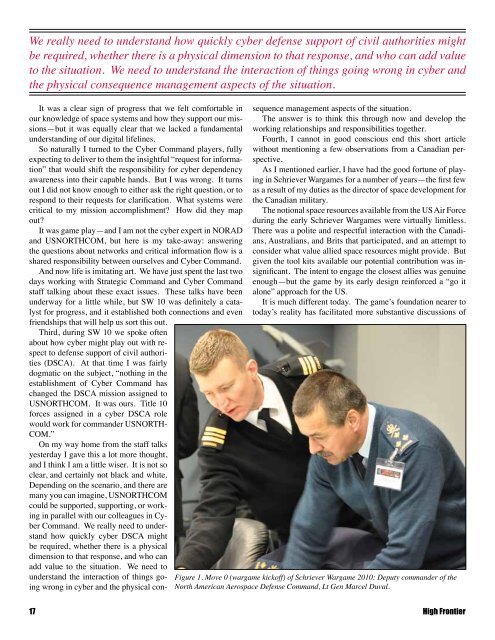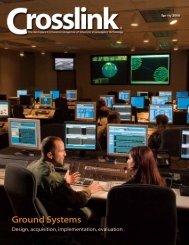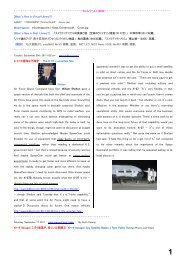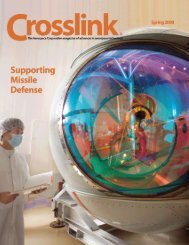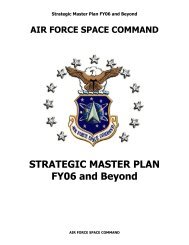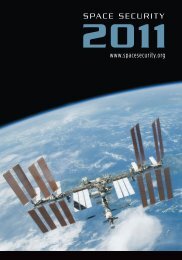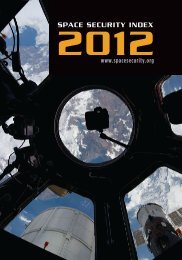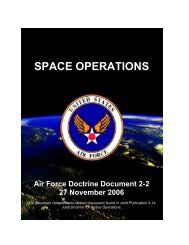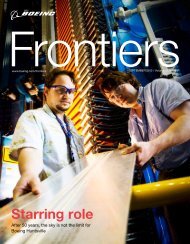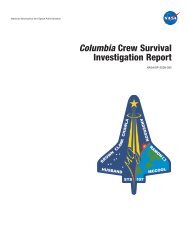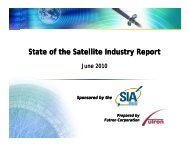Schriever Wargame 2010 - Air Force Space Command
Schriever Wargame 2010 - Air Force Space Command
Schriever Wargame 2010 - Air Force Space Command
You also want an ePaper? Increase the reach of your titles
YUMPU automatically turns print PDFs into web optimized ePapers that Google loves.
We really need to understand how quickly cyber defense support of civil authorities might<br />
be required, whether there is a physical dimension to that response, and who can add value<br />
to the situation. We need to understand the interaction of things going wrong in cyber and<br />
the physical consequence management aspects of the situation.<br />
It was a clear sign of progress that we felt comfortable in<br />
our knowledge of space systems and how they support our missions—but<br />
it was equally clear that we lacked a fundamental<br />
understanding of our digital lifelines.<br />
So naturally I turned to the Cyber <strong>Command</strong> players, fully<br />
expecting to deliver to them the insightful “request for information”<br />
that would shift the responsibility for cyber dependency<br />
awareness into their capable hands. But I was wrong. It turns<br />
out I did not know enough to either ask the right question, or to<br />
respond to their requests for clarification. What systems were<br />
critical to my mission accomplishment? How did they map<br />
out?<br />
It was game play—and I am not the cyber expert in NORAD<br />
and USNORTHCOM, but here is my take-away: answering<br />
the questions about networks and critical information flow is a<br />
shared responsibility between ourselves and Cyber <strong>Command</strong>.<br />
And now life is imitating art. We have just spent the last two<br />
days working with Strategic <strong>Command</strong> and Cyber <strong>Command</strong><br />
staff talking about these exact issues. These talks have been<br />
underway for a little while, but SW 10 was definitely a catalyst<br />
for progress, and it established both connections and even<br />
friendships that will help us sort this out.<br />
Third, during SW 10 we spoke often<br />
about how cyber might play out with respect<br />
to defense support of civil authorities<br />
(DSCA). At that time I was fairly<br />
dogmatic on the subject, “nothing in the<br />
establishment of Cyber <strong>Command</strong> has<br />
changed the DSCA mission assigned to<br />
USNORTHCOM. It was ours. Title 10<br />
forces assigned in a cyber DSCA role<br />
would work for commander USNORTH-<br />
COM.”<br />
On my way home from the staff talks<br />
yesterday I gave this a lot more thought,<br />
and I think I am a little wiser. It is not so<br />
clear, and certainly not black and white.<br />
Depending on the scenario, and there are<br />
many you can imagine, USNORTHCOM<br />
could be supported, supporting, or working<br />
in parallel with our colleagues in Cyber<br />
<strong>Command</strong>. We really need to understand<br />
how quickly cyber DSCA might<br />
be required, whether there is a physical<br />
dimension to that response, and who can<br />
add value to the situation. We need to<br />
understand the interaction of things going<br />
wrong in cyber and the physical consequence<br />
management aspects of the situation.<br />
The answer is to think this through now and develop the<br />
working relationships and responsibilities together.<br />
Fourth, I cannot in good conscious end this short article<br />
without mentioning a few observations from a Canadian perspective.<br />
As I mentioned earlier, I have had the good fortune of playing<br />
in <strong>Schriever</strong> <strong>Wargame</strong>s for a number of years—the first few<br />
as a result of my duties as the director of space development for<br />
the Canadian military.<br />
The notional space resources available from the US <strong>Air</strong> <strong>Force</strong><br />
during the early <strong>Schriever</strong> <strong>Wargame</strong>s were virtually limitless.<br />
There was a polite and respectful interaction with the Canadians,<br />
Australians, and Brits that participated, and an attempt to<br />
consider what value allied space resources might provide. But<br />
given the tool kits available our potential contribution was insignificant.<br />
The intent to engage the closest allies was genuine<br />
enough—but the game by its early design reinforced a “go it<br />
alone” approach for the US.<br />
It is much different today. The game’s foundation nearer to<br />
today’s reality has facilitated more substantive discussions of<br />
Figure 1. Move 0 (wargame kickoff) of <strong>Schriever</strong> <strong>Wargame</strong> <strong>2010</strong>: Deputy commander of the<br />
North American Aerospace Defense <strong>Command</strong>, Lt Gen Marcel Duval.<br />
17 High Frontier


